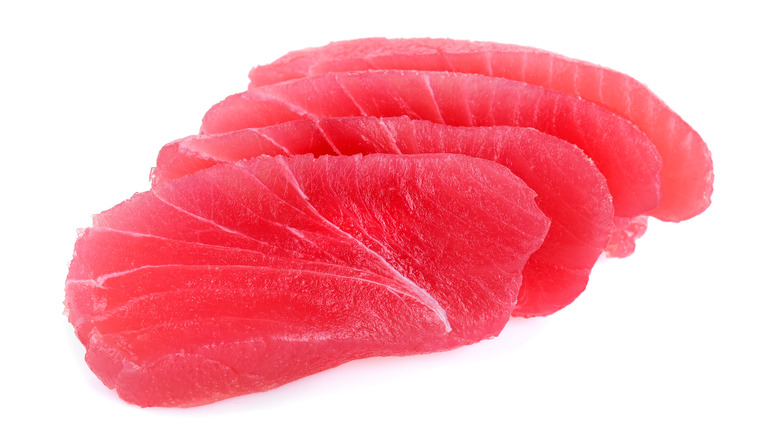The Controversial Practice That Keeps Tuna Looking Fresh
We all know that freshness is key when it comes to food. Not only does fresh food often taste better, but it's usually safer as well. So what do you look for when you're looking for fresh tuna? If you say a bright red color, you're not alone. After all, when tuna is exposed to air, it quickly starts to turn an unappetizing shade of brown, as a result of oxidation. And according to The New York Times, most consumers want to see tuna that is bright red in color, which they consider to be a sign of quality and freshness. This is despite the fact that fresh tuna can range in color from a pale pink (for the "finest fresh Bluefin") to a brownish red (for "top-quality toro").
Another problem? There are also ways to mimic this fresh looking bright red color, and the practice is a controversial one that has been banned in some areas of the world, including the European Union, Canada, Singapore, and Japan, but not the United States. That practice? Treating tuna with carbon monoxide to keep it looking fresher longer. Yes, that same carbon monoxide that comes out of your tailpipe, and could be fatal when inhaled. That carbon monoxide.
Carbon monoxide treated tuna may hide spoilage
Carbon monoxide, although potentially fatal if inhaled, is actually safe when used in this context. The FDA considers tuna that has been treated with carbon monoxide to be GRAS, or generally regarded as safe (via ABC News). The problem, however, is not the carbon monoxide itself, but that it allows tuna to retain its color for a really long time (up to a year even), which could be used to hide the fact that the tuna has spoiled. Carbon monoxide only affects the color of the tuna, it doesn't actually prevent spoilage or bacterial growth (at least, not in the quantities that are legally allowed). Salmonella outbreaks have occurred with imported tuna that have been treated with carbon monoxide, including a 2015 incident that affected nine states.
The FDA has warned that color alone should not be taken as an indicator of freshness, citing a number of factors that include the use of "color fixatives such as carbon monoxide." Smell is usually another way to tell if something has spoiled, but the use of carbon monoxide also masks the smell that would otherwise develop in spoiling food, warns San Diego Magazine. Your best bet if you have concerns about carbon monoxide-treated tuna? Get your poke, sushi, and sashimi from trusted restaurants and shops that source their tuna from reputable sources.

